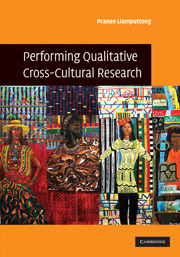Book contents
- Frontmatter
- Contents
- Preface
- About the author
- About the book
- 1 Performing qualitative cross-cultural research: an introduction
- 2 Moral and ethical perspectives
- 3 The research participants: accessing and reciprocity
- 4 Cultural sensitivity: a responsible researcher
- 5 Insider/Outsider perspectives and placing issues
- 6 Cross-cultural communication and language issues
- 7 Personal and collective testimony
- 8 Local knowledge, local power and collective action
- 9 Writing and disseminating in cross-cultural research
- In closing …
- References
- Index
- References
9 - Writing and disseminating in cross-cultural research
Published online by Cambridge University Press: 05 June 2012
- Frontmatter
- Contents
- Preface
- About the author
- About the book
- 1 Performing qualitative cross-cultural research: an introduction
- 2 Moral and ethical perspectives
- 3 The research participants: accessing and reciprocity
- 4 Cultural sensitivity: a responsible researcher
- 5 Insider/Outsider perspectives and placing issues
- 6 Cross-cultural communication and language issues
- 7 Personal and collective testimony
- 8 Local knowledge, local power and collective action
- 9 Writing and disseminating in cross-cultural research
- In closing …
- References
- Index
- References
Summary
When we are dealing with marginalised or silenced voices researchers have a responsibility to challenge this silencing, or at least to provide some sort of public space for alternative and/or occluded views to be aired. As an African saying reminds us, until the hunted have their poets then songs of the hunt will always glorify the hunter, not the prey.
(Brockington & Sullivan 2003: 63–64)In this chapter, I will discuss the way we write to represent the voices of our research participants in cross-cultural research. There are several salient issues that I believe deserve great attention from researchers. For example: How do we write our research findings in a way that what we write will not further marginalise our participants? In what language should we write the findings? Who owns the research findings? I shall also suggest ways that we can write up the findings sensitively and make use of innovative writing strategies. When we have finished our research project, it is important for us to disseminate the research findings. How do we do this in cross-cultural research so that the findings can be fed back to our participants and reach wider audiences? This will be addressed in this chapter.
Writing cross-cultural research
How do we write in a way that our writing will not further marginalise our research participants? This is a contentious issue in any sensitive research, but even more so in cross-cultural research, when we often work with very marginalised people.
- Type
- Chapter
- Information
- Performing Qualitative Cross-Cultural Research , pp. 212 - 235Publisher: Cambridge University PressPrint publication year: 2010



